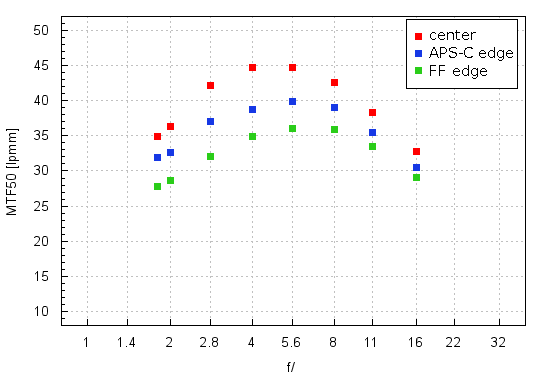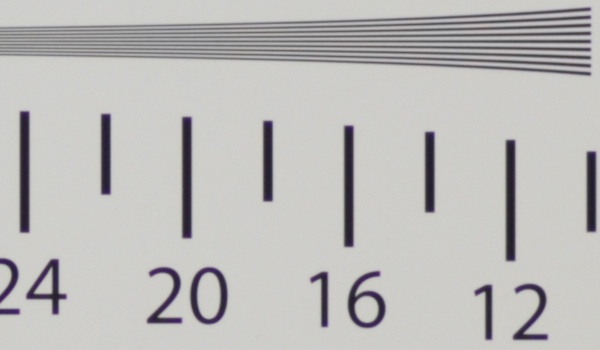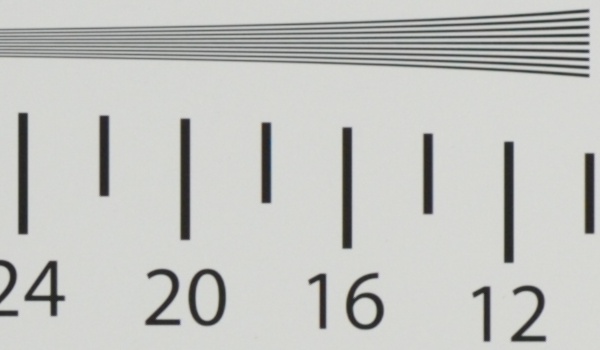Tamron SP 45 mm f/1.8 Di VC USD
4. Image resolution
Let’s see how the tested lens compares here.

Please Support UsIf you enjoy our reviews and articles, and you want us to continue our work please, support our website by donating through PayPal. The funds are going to be used for paying our editorial team, renting servers, and equipping our testing studio; only that way we will be able to continue providing you interesting content for free. |
- - - - - - - - - - - - - - - - - - - - - - - - - - - - - - - - - - - - - - - - - - - - - - - -
First the maximum MTF results which, by f/4.0 and f/5.6 apertures, get close to 45 lpmm. It is a high level but also one that leaves us unsatisfied a bit. The Otus was able to get to 50 lpmm but, after all, that lens is a class of its own. The Sigma A 1.4/50 was tested on the Canon 5D MkIII which usually generates MTFs by about 1–2 lpmm lower than the Nikon D3x but still it managed to reach as high as 47 lpmm. Compared to that the results of the Tamron seem to be by 2-3 lpmm too low. Is it due to the inferior aperture fastness? Partially yes, the Otus and the Sigma being faster had it certainly easier when it comes to break resolution records. On the other hand the Nikkor AF-S 50 mm f/1.8G, a much simpler device construction-wise and cheaper too, by f/4.0–5.6 also could achieve results near 45 lpmm, and the Canon EF 50 mm f/1.8 STM reached even as high as 46 lpmm. More optically complex Tamron doesn’t seem to provide a better performance than the old 1.8/50 models. It is a very interesting conclusion, especially when you remind yourself the declaration of the producer about an excellent cooperation with 50-million pixel sensors.
In order to defend the Tamron a bit and to keep the right point of reference you should add that the popular and widely praised Nikkor AF-S 50 mm f/1.4G by f/4.0–5.6 apertures managed to get just near 41–43 lpmm so noticeably lower than the Tamron.
On the one hand we expected the Tamron to reach a level of 47-49 lpmm. On the other hand those 45 lpmm are perhaps not worth the panic – such a result still allows you to enjoy really sharp images and there are significant differences between the performance of the older constructions and the new Tamron in other places too.
First of these places is situated near the maximum relative aperture. By f/1.8 the Tamron’s MTFs are situated near 35 lpmm so significantly above the decency level. The Nikkor AF-S 50 mm f/1.8G, mentioned by us above, barely exceeded 26 lpmm in that place. You have to admit the difference is significant.
Edges of the frame are the second place where the Tamron prevails over the older constructions. Even at the maximum relative aperture the images from the Tamron on the edge of the APS-C sensor are perfectly useful and on the edge of full frame the MTFs are really very close to the decency level. Compare that with the results of the Nikkor 1.8/50G which could barely exceed 20 lpmm, or the Canon 1.8/50 STM which reached values near 22–23 lpmm.
There is also a piece of bad news for the Tamron and it is called the Sigma A 50 mm f/1.4 DG HSM. Being a bit more expensive it still remains faster aperture-wise (although it comes without any stabilization system). However, its maximum relative aperture amounts to f/1.4 so if you stop it down to f/1.8, the biggest aperture offered by the Tamron, the MTFs soar to near 32-33 lpmm. As a result at every aperture value of those two lenses which can be directly compared the Sigma remains a bit sharper than the Tamron, no matter whether you look at the frame centre or the edge of the frame.
At the end of this chapter, traditionally, we present crops taken from photos of our resolution testing chart, saved as JPEG files along with RAW files we used for the analysis above.
| Nikon D3x, JPEG, f/1.8 |
 |
| Nikon D3x, JPEG, f/4.0 |
 |






